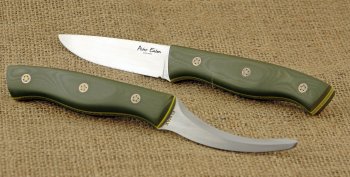izafireman
Well-Known Member
I made these two knives recently and as you can see the curved blade has a 'Scandi' grind for deer gralloching ie stomach removal in the field.
The curved blade was a challenge as I had the blade in a jig and had to move it along the belt in a sweeping/ curving motion in order to grind it as impossible of course to grind it like a straight bladed Scandi. This led to an issue where I was going off the back of the table as the blade moved around the belt to the tip when grounding....hope I am explaining this so you can follow?
Now I want to find a faster / easier process to do this curved grind. My thought are to make a table that extends a few inches behind the platen so I wont go off the back or I was thinking, though this mean a lot more work maybe a platen with a curved face that the belt would follow.....but would the belt track OK for the plunge lines?
So they are my ideas, might be dumb, I don't know but if anyone can help me or point my to videos that might explain this better it would be much appreciated.
Thanks in advance
Pete
The curved blade was a challenge as I had the blade in a jig and had to move it along the belt in a sweeping/ curving motion in order to grind it as impossible of course to grind it like a straight bladed Scandi. This led to an issue where I was going off the back of the table as the blade moved around the belt to the tip when grounding....hope I am explaining this so you can follow?
Now I want to find a faster / easier process to do this curved grind. My thought are to make a table that extends a few inches behind the platen so I wont go off the back or I was thinking, though this mean a lot more work maybe a platen with a curved face that the belt would follow.....but would the belt track OK for the plunge lines?
So they are my ideas, might be dumb, I don't know but if anyone can help me or point my to videos that might explain this better it would be much appreciated.
Thanks in advance
Pete

